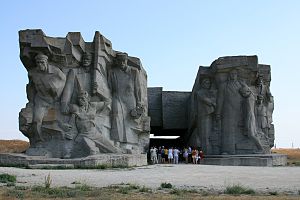- Defense of the Adzhimushkay quarry
-
Defense of the Adzhimushkay quarry Part of the Eastern Front of World War II 
Monument to defenders of AdzhimushkayDate May 16 – October 30, 1942 Location Adzhimushkay, Crimea, USSR
45°22′52″N 36°31′25″E / 45.3812°N 36.5235°EResult German victory Belligerents  Germany
Germany Soviet Union
Soviet UnionCommanders and leaders  Erich von Manstein
Erich von Manstein P.M. Yagunov,
P.M. Yagunov,
 M.G. Povazhniy
M.G. PovazhniyStrength Several regiments 10,000 - 15,000 Casualties and losses Unknown 10,000+ 1st Crimea – Kerch Peninsula – Adzhimushkay – Sevastopol – Caucasus – Kerch–Eltigen Operation (1943) – 2nd CrimeaThe Defense of the Adzhimushkay quarry (Russian: Оборона Аджимушкайских каменоломен, Oborona Adzhimushkajskih kamenolomen), was an action on the Eastern Front in World War II that occurred between May and October 1942.
Contents
History
Adzhimushkay is a small village located five kilometers from the city of Kerch, near which a complex network of catacombs is located. Limestone was extracted there from 1830, both from the quarry and the catacombs. Over the years, an underground network was created, encompassing the Great and Small Adzhimushkay catacombs. They were used during the Russian Civil War by pro-Soviet armed groups. When Kerch was first occupied by the Wehrmacht in November 1941, a squad of partisans operated in the catacombs.
By May 1942, a massive counteroffensive was staged by the Wehrmacht in order to expel the Red Army both from the Kerch Peninsula and the city of Sevastopol. The Soviet high command had neglected to build comprehensive defenses; the Red Army was overrun and had to flee, sustaining heavy casualties. By May 19, 1942 the battle was over.
In order to ensure the evacuation of the troops across the Kerch strait, a defense group was left in Adzhimushkay, led by Colonel P.M. Yagunov. This group picked up numerous retreating soldiers and eventually grew to several thousand strong, along with numerous civilians fleeing the city. When it became obvious that the bridgehead could not be held, the defenders decided to take refuge in the catacombs. It is estimated that more than 10,000 survivors fled to the Great Adzhimushkay catacombs and 3,000 to the Small catacombs. The larger garrison was led by Yagunov and the smaller one by Povazhniy.
The catacombs were ill-suited for defense, as there were no supplies prepared and all wells were located outside. Any supply of water had to be taken by force since a sortie was needed to reach a well. The defenders later dug their own wells in the catacombs, as deep as 14 m, in order to reach the phreatic layer. Despite these conditions, the Red Army attempted several sorties, including one that led to the defeat of the Wehrmacht's garrison in Adzhimushkay on the night of 8 and 9 July 1942. Colonel Yagunov was killed in this assault.
However, the situation for the defenders was becoming critical, as they were running out of ammunition, food and water. Moreover, the German forces began using explosives and toxic gas[1] to end the resistance. On October 30, 1942, German forces finally entered the catacombs and captured the remaining defenders. Of the 13,000 or so people who took refuge in the catacombs, only 48 were still alive at the end of the 170 day siege.
Aftermath
This dramatic event was heavily popularized after the war. Several books and songs were written to commemorate it. A museum was erected in the catacombs in 1966 and a memorial in 1982.
Notes
- ^ Halder, F., Kriegstagebuch. Tägliche Aufzeichnungen des Chefs des Generalstabes des Heeres 1939–1942. — Stuttgart, W. Kohlhammer Verlag, 1962–1964 (entry dated June 13, 1942).
References and links
- Great Soviet Encyclopedia
- V. Abramov, The Crimean Catastrophe, 1942., Eksmo, 2006, ISBN 5-699-15686-0.
- http://info.crimea-portal.gov.ua/
- http://travel.kyiv.org/crimea/
Categories:- Kerch
- Battles and operations of the Soviet–German War
- History of Crimea
- Conflicts in 1942
Wikimedia Foundation. 2010.
